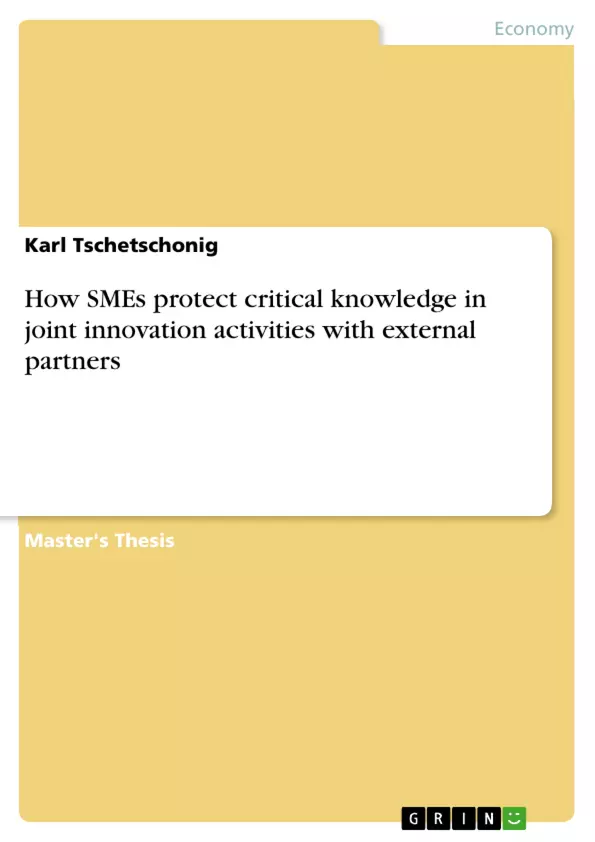For small firms, knowledge leakage, loss and theft are counted among the greatest risks in inter-firm collaborations. SMEs are more vulnerable, because they suffer from a number of structural disadvantages when collaborating with larger companies, and yet, they need to collaborate with external partners to overcome their lack of resources.
Therefore, this study investigates how SMEs can most effectively protect critical knowledge in collaborations with external partners, for that they can prevent knowledge loss, leakage and theft, while maximizing the performance of the collaboration. Based on a comprehensive review of existing literature, and a qualitative multiple-case study evaluation, where highly innovative and successful SMEs in Germany contributed their experiences, I have derived valuable insights for practice and theory.
Overall, the most commonly used means of protecting critical knowledge were secrecy, patents, the systematic selection of partners, and contracts. Despite the importance given to these mechanisms, not all of them proved to be effective. In fact, trust, secrecy and the systematic selection of partners were considered to be most effective, while initial secrecy and patents were concluded to overprotect knowledge, thus, limiting the possible overall innovative performance. Complementary assets, rotating personnel, oligopolistic market structures, equity relationships, technical means of protection, and employee contracts were found to be entirely ineffective for SMEs.
When analyzing the relations of protection mechanisms, a significant correlation between the type of protection and the openness to external innovation emerged: companies, which used initial secrecy and patents to protect knowledge, did not collaborate with external partners to co-develop new ideas, while companies, which focused on trust as a means of protection, were much more likely to do so. What is more, SMEs did not differentiate these strategies for different types of partners and they generally preferred to collaborate with smaller firms. In fact, it turned out that strategies are influenced by a number of factors including experiences made in previous collaborations.
Inhaltsverzeichnis (Table of Contents)
- 1. INTRODUCTION AND RESEARCH QUESTION
- 1.1. Background
- 1.2. Research question
- 1.3. Outline of the report
- 2. THEORY
- 2.1. Means of protecting critical knowledge
- 2.1.1. Long term (strategic) means of protection
- 2.1.2. Medium term (tactical) means of protection
- 2.1.3. Short term (operational) means of protection
- 2.1.4. Overarching factors
- 2.1.5. Other
- 2.2. Strategies of protecting critical knowledge
- 2.2.1. Dilemma of openness and protection
- 2.2.2. Factors and determinants
- 2.2.3. Unique opportunities and challenges of smaller companies
- 2.2.4. Interrelations and trade off of protection mechanisms
- 2.2.5. Current best practices
- 3. METHODOLOGY
- 3.1. Research Design: Building theory from case studies
- 3.2. Research field
- 3.2.1. "Top 100 Unternehmen"
- 3.2.2. Research sample
- 3.3. Data collection: Interviews and secondary sources
- 3.4. Data analysis
- 4. FINDINGS
- 4.1. Protection strategies
- 4.1.1. Formal vs. informal means of protection
- 4.1.2. Means of protection vs. openness to external partners
- 4.1.3. Strategic groups
- 4.2. Cross-case patterns and relationships
- 4.2.1. Initial secrecy and patents reduce possible innovative performance
- 4.2.2. Influencing factors and the relevance of personal experiences
- 4.2.3. Strategies do not differ for different collaboration partners
- 4.2.4. SMEs prefer to collaborate with small partners
- 4.2.5. Large companies can protect knowledge better
- 4.3. Protection mechanisms
- 4.3.1. Distribution of protection mechanisms
- 4.3.2. Detailed evaluation of protection mechanisms
- 5. DISCUSSION & IMPLICATIONS
- 5.1. Conclusion
- 5.2. Managerial implications
- 5.3. Further research
- 5.4. Limitations
Zielsetzung und Themenschwerpunkte (Objectives and Key Themes)
This study aims to investigate how SMEs can effectively protect critical knowledge in collaborations with external partners to prevent knowledge loss, leakage, and theft while maximizing the performance of the collaboration. The research focuses on the specific challenges and opportunities facing SMEs in this context. Key themes explored in the study include: * **Means of Protecting Critical Knowledge**: Examining various methods for safeguarding valuable knowledge, including formal and informal approaches. * **Strategies of Protecting Critical Knowledge**: Analyzing the interplay between openness and protection, identifying factors that influence strategy choices, and recognizing the unique challenges faced by smaller companies. * **Openness and Innovation**: Investigating the relationship between knowledge protection mechanisms and a company's willingness to engage in external innovation. * **Collaboration Partner Selection**: Exploring the criteria used by SMEs when choosing partners for joint innovation activities. * **Factors Influencing Protection Strategies**: Identifying key factors that shape the choices SMEs make regarding knowledge protection.Zusammenfassung der Kapitel (Chapter Summaries)
- Chapter 1: Introduction and Research Question This chapter sets the stage for the study by introducing the problem of knowledge leakage in inter-firm collaborations and the vulnerability of SMEs. It also states the research question: how can SMEs best protect critical knowledge in collaborations with external partners?
- Chapter 2: Theory This chapter provides a theoretical framework for the study by discussing various means of protecting critical knowledge, including long-term, medium-term, and short-term strategies. It also explores the dilemma of openness and protection, factors influencing protection strategies, and the specific challenges and opportunities for smaller companies.
- Chapter 3: Methodology This chapter details the research design, including the selection of the research field, research sample, and data collection methods. It also explains the data analysis techniques used in the study.
- Chapter 4: Findings This chapter presents the findings of the study, analyzing the protection strategies employed by SMEs, the relationships between different protection mechanisms, and the factors influencing these choices.
Schlüsselwörter (Keywords)
The primary keywords and focus topics of the study include knowledge protection, SME collaboration, innovation, external partners, strategic decision-making, and inter-firm relationships. The study explores the challenges and opportunities associated with protecting critical knowledge in the context of joint innovation activities, with a particular focus on the unique vulnerabilities and advantages of SMEs.- Quote paper
- Karl Tschetschonig (Author), 2011, How SMEs protect critical knowledge in joint innovation activities with external partners, Munich, GRIN Verlag, https://www.grin.com/document/185044



